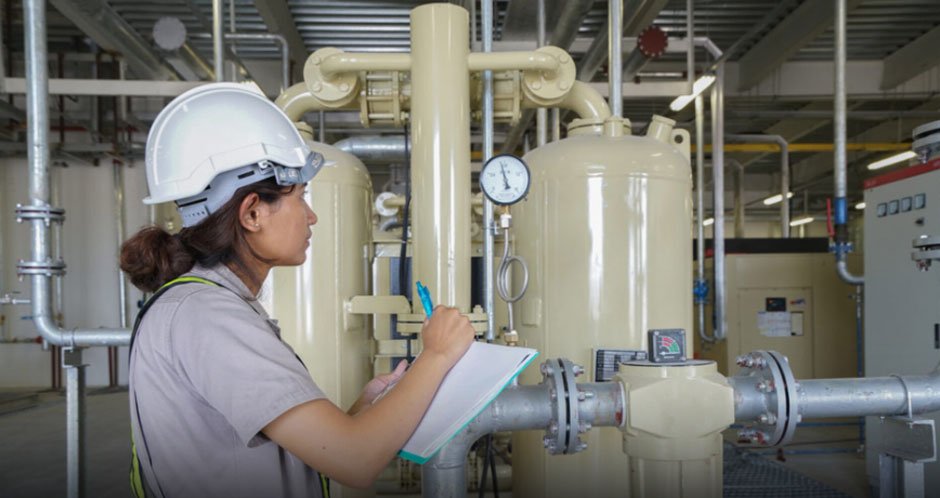Skip to the good bit
ToggleAir compressors play a crucial role in various industries. They provide compressed air to power tools and equipment. Regular inspections help these machines operate efficiently, reducing downtime and the need for costly repairs. While checking and maintaining equipment might seem boring, doing it regularly saves time and money in the long run. It also extends the machine’s lifespan and improves its performance.
Here are some effective practices for inspecting air compressors.
Know the Basics
Air compressors have complex systems with numerous components that must work together. Understanding how the main components, such as the motor, pump, and air tank, function is essential for conducting adequate inspections. Always refer to the manufacturer’s manual for specific insights about your model. Schedule regular inspections to identify potential problems before they escalate into major issues.
One important thing to check for during inspections is air leaks. A small leak may not seem like a significant issue, but it can waste energy and reduce performance over time. Listen for hissing sounds and inspect hoses and fittings for signs of wear. Tightening connections or replacing parts can save energy and improve productivity.
Screw Compressors
Screw compressors are efficient and reliable, making them a popular choice in many settings. They use rotating helical screws to continuously compress air. This feature provides a steady supply of compressed air, lowering operational costs since these compressors typically consume less energy.
A screw compressor also requires less maintenance than other types, meaning less downtime. They operate quietly, which is beneficial in workplaces where noise levels need to be kept low. Choosing a screw compressor can simplify operations, helping businesses focus on productivity without the distractions of louder traditional compressors.
Routine Maintenance
Setting up a regular maintenance schedule is essential for checking air compressors. This schedule should include checking oil levels, replacing filters, and looking at belts for wear. Changing the oil regularly helps the compressor run smoothly and efficiently, while clean filters ensure proper airflow and stop dust from clogging essential parts.
Watch the temperature gauges too. If the compressor overheats, it could indicate problems that may interrupt work. If you notice unusual temperature spikes, check the coolant levels and ensure proper airflow around the compressor. Keeping the machine cool enhances performance and provides a safer working environment.
Monitoring Performance
A crucial aspect of inspecting air compressors is monitoring their performance. Pay attention to key metrics such as cycle time, pressure readings, and output volume. Sudden changes in these numbers can mean it’s time for a closer look.
Keep a log of these performance indicators. Consistently tracking this data helps you spot issues early. This historical data helps understand how your compressor works, and it can save you time and money on repairs.
Environmental Considerations
When inspecting air compressors, consider the environment surrounding them. Good ventilation is crucial for compressors to function properly. Ensure the area is free from dust, moisture, and extreme temperatures, as these can compromise performance and accelerate wear.
Additionally, consider noise-reduction options if your compressor is located in a noisy area. Basic soundproofing or vibration-dampening materials can create a more pleasant working space.
Safety First
Safety is always the top priority during inspections. Before doing any maintenance or inspection work, turn off the compressor and release any remaining pressure in the system. This step is crucial for preventing accidents and ensuring a safe workspace.
Use personal protective equipment (PPE), like gloves and goggles, when examining the compressor. Taking these precautions protects you and shows a commitment to workplace safety, which is important for everyone working nearby.
Training and Skill Development
Proper training for employees who work with air compressors is crucial for practical inspection and maintenance. Trained staff can identify potential problems early, operate equipment safely, and complete routine tasks with confidence.
Regular workshops or refresher courses keep their skills sharp and up to date with current industry practices. Promoting a culture of continuous learning helps improve team knowledge and boosts overall workplace efficiency and safety.
Documentation and Reporting
Maintaining detailed records of inspections, maintenance activities, and performance metrics is crucial for effectively managing air compressors. Documentation helps track each unit’s history, making it easier to spot patterns and predict future maintenance needs.
Develop a comprehensive reporting system for inspections that includes detailed notes on any issues identified and the corresponding actions taken. This transparency promotes accountability within the team and can significantly reduce the risk of missing critical maintenance tasks. Regularly reviewing these records can also inform future purchases and operational improvements.







